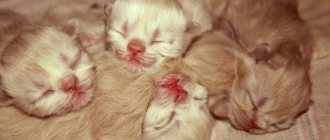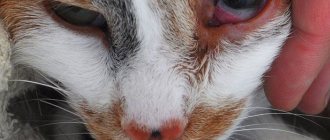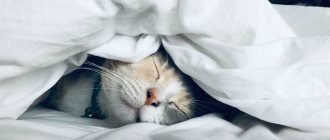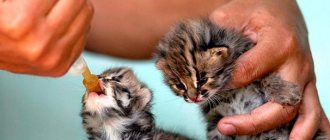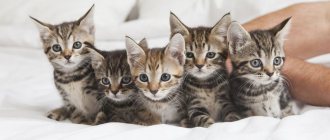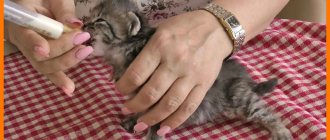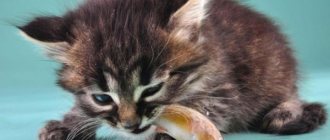Based on materials from the website www.icatcare.org
Unfortunately, when awaiting the birth of kittens, you must be prepared for the fact that some of them may not survive. In purebred cats, the early mortality rate of kittens is slightly higher than in domestic cats. One study provides data that about 7% of purebred kittens are stillborn, 9% die during the first eight weeks of life (mostly from the first to the third week). The number of kittens surviving after 8 weeks of life varies between breeds (from 75% to 95%), Persian kittens are the most likely to die.
Most kittens that are not destined to survive die before birth (they are stillborn) or in the first week of life. The number of deaths in kittens that lived for more than a week is significantly less. As a rule, while the cat is nursing kittens, death occurs from “non-infectious” causes; mortality from infectious diseases increases after the kitten is taken from its mother. This is because kittens receive protection against many infections through their mother's milk. Kittens that die between birth and weaning are called “fading.”
Newborn kittens may die suddenly or decline gradually over several days. Unfortunately, the clinical signs of many diseases affecting newborn kittens are very similar and vague. If healthy kittens tend to gather in a group and sleep between feedings, then sick kittens often lie separately, are more restless, suck poorly, and often squeak (while they have enough strength to do so).
Newborn kittens are more vulnerable because their body temperature regulation mechanisms and immune system are still developing, and they have an increased risk of dehydration and low blood sugar (hypoglycemia). Therefore, regardless of the original cause, the kitten can die very quickly.
Causes of early mortality of kittens.
Hypothermia
(hypothermia). Newborn kittens are at risk of hypothermia because their bodies are unable to maintain body temperature, making them dependent on the cat and the temperature in the room. Hypothermia, in particular, is dangerous because it can cause a decrease in breathing and heart rate, which leads to cardiovascular failure. Also, with hypothermia, kittens often cannot suckle well, which accelerates the development of problems. Rectal temperature in kittens should be between 35-37°C in the first week, 36-38°C in the second and third weeks, and reaches a normal adult cat temperature of 38-39°C by the fourth week of life.
Low sugar level
in the blood (hypoglycemia). Newborn kittens need a lot of energy, but they have no reserves to conserve it, so they are completely dependent on their mother's milk. Sick kittens may not consume the required amount of milk, which quickly leads to the development of hypoglycemia. This can manifest itself in weakness, decreased temperature, squeaking, difficulty breathing, and convulsions.
Dehydration
(dehydration). At an early age, the risk of dehydration in kittens is increased, since their body contains a relatively high amount of fluid, and the mechanisms of protection against water loss have not yet been fully formed; water is quickly excreted through the kidneys, lungs and skin. Diarrhea also increases water loss. Normally, newborn kittens require approximately 130-220 ml/kg per day of water, while an adult cat only needs 50-65 ml/kg. Dehydration develops quickly when there is a lack of milk intake or increased water loss (usually as a result of overheating or diarrhea).
Alarming symptoms of approaching death
Unfortunately, weak, sick or premature pets die during the first days of life or are already born dead.
In this case, it is impossible to help, since there is no point in fighting natural selection. But a kitten more than 2-3 weeks old needs a veterinarian if the following symptoms are present:
- high or low body temperature (37–39 ⁰C is considered normal);
- refusal to eat;
- vomiting or diarrhea;
- weight loss;
- sneezing, difficulty breathing, cough;
- discharge from the nose and eyes;
- bleeding;
- injuries.
The most common causes of early kitten mortality.
Reasons related to childbirth and mother.
Hypoxia
(lack of oxygen), injuries, hypothermia. Kittens born after a difficult birth (dystocia) are much more likely to die as infants. This occurs as a result of possible birth injuries and (or) hypoxia. Research shows that cats with extreme features, such as the flat face of the Persian, are more likely to have difficulty giving birth, likely due to a combination of features such as the kitten's relatively large size, large head, and the cat's narrow pelvis. Due to the lack of oxygen during birth, kittens may be born dead or too weak to suckle enough milk afterwards.
First birth
at the cat. Kittens from the first litter have a higher mortality rate on average, likely due to the cat's inexperience, injury, and possible cannibalism. Cats that have given birth multiple times (more than five times) may also experience difficulty during labor.
Obesity
cats. Mortality among kittens whose mother is overweight also increases.
Others
Reasons: lack of milk, mastitis, abandonment of kittens.
Congenital anomalies in kittens.
Congenital anomalies are physical defects that are present from birth. These can be both genetic abnormalities and disorders during intrauterine development (for example, due to the use of medications, past illnesses, etc.), leading to the formation of defects in the fetus. The most common birth defects are:
- Cleft palate;
- Umbilical hernia;
- Skeletal defects;
Kittens with significant defects are usually stillborn or die in the first days of life. Moderate disorders lead to the decline of kittens or may appear at an older age. Since inbreeding also increases the risk of inherited diseases, hereditary disorders are more common in purebred cats.
The kitten is underweight.
Low weight kittens are more at risk of hypothermia, dehydration, respiratory problems and infectious diseases, which significantly increases the risk of early death. Kittens may be born underweight due to maternal malnutrition, disease, birth defects, or other causes that result in poor blood supply to the placenta.
The average weight of a newborn kitten for domestic cats and most pedigree cats ranges from 90 to 100 grams, although some breeds have a normal kitten weight that is less (for example, Oriental cats) and some more (Maine Coons). If a kitten weighs less than 75g, the likelihood of death is quite real.
Poor conditions for the development of a kitten.
The environment significantly influences kitten mortality:
Air temperature
. Room temperature is very important for the proper development of kittens. If kittens are cold, they very quickly get tired of sucking milk, which leads to hypothermia and hypoglycemia. To maintain temperature (especially for orphaned kittens), it may be necessary to warm their box to a temperature of 29-32°C, and the kittens should be able to freely move away from the heater to a cooler area. By 7-10 days the temperature can be gradually reduced to 27°C, and by the end of the first month of life - to 22-25°C.
Poor hygiene
. Increases the risk of infectious diseases.
A large number of kittens
. Increases the risk of infectious diseases and malnutrition as a result of competition for food (milk).
Excessive cat care
. Constant licking of kittens can limit their time for feeding, and in nervous cats even lead to cases of cannibalism. Since newborn kittens cannot shiver, which prevents them from maintaining body temperature, they may become hypothermic, which in turn leads to a further decrease in activity and milk output.
Improper cat nutrition.
It is very important that the food meets the needs of a nursing cat, since the quality of milk depends on it, which greatly affects the health of kittens. It is advisable to feed your cat high-quality food designed specifically for nursing cats.
A lack of milk produced by a cat can have the following reasons:
Insufficient milk intake in a kitten can occur as a result of:
- Deterioration in health or weakness;
- Competition with other kittens;
- Poor living conditions;
Signs of low milk supply for kittens.
For control, kittens should be weighed immediately after birth, weighed daily during the first week and twice a week starting in the second week of life. Normal indicators must meet the following parameters:
- In the first day, the kitten can lose no more than 10% of its weight;
- From the second day the kitten should gain 10-15g/day (5-10%);
- The kitten's weight should double in 1-2 weeks;
Any weight loss (or lack of weight gain) should be cause for concern.
If a cat does not produce enough milk, the kittens need additional nutrition.
Neonatal isoerythrolysis.
For some cat breeds, neonatal isoerythrolysis is a fairly common cause of death in kittens. The cause of death in this case is the incompatibility of the blood groups of the cat and the kitten.
Infectious diseases (viral, bacterial, parasitic).
The kitten should begin suckling within the first 2 hours of life. Kittens receive antibodies from the cat's milk by absorbing them during the first 16 to 24 hours of life, so it is important that they nurse well during this period. Milk is necessary not only for good nutrition, but also for the acquisition of maternal derived immunity, which protects them from infections.
How to help a dying kitten?
All you can do for a newly born kitten is to provide it with warmth and enough food. If the cat cannot feed it, then you need to buy a special mixture from the veterinary store. It is ideal when you manage to throw a baby to another cat that has recently given birth. Cow's milk is not digested by your pet's stomach
, but in extreme cases, goat's, diluted half with water, will do. While you are looking for nutritious food, give your baby warm boiled water from a pipette or syringe without a needle. This will prevent dehydration.
Never pick up a kitten without first washing them with soap. Otherwise, there is a high risk of contracting an infection.
After each feeding, gently wipe the kitten's genitals with a damp cotton pad. They do this to stimulate bowel movements. The pet does not yet know how to relieve itself on its own, and it needs help. After the process is completed, urine and feces are removed with a damp cloth, and the fur is wiped dry.
If you are worried that you will not be able to cope with your responsibilities, then it is better to look for a special shelter where such animals are accepted. Professionals know better how to handle newborn babies. Therefore, these kittens have a great chance of survival.
If, despite your efforts, your pet dies, remember that you did everything possible to save it. It is important to understand that a newborn baby definitely needs a mother.
, which cannot be replaced even by round-the-clock human care. After the death of a kitten, it is better to bury it in a beautiful place outside the city or in the private sector, unless this is prohibited by law.
VETERINARIAN CONSULTATION REQUIRED. INFORMATION FOR INFORMATION ONLY. Administration
The death of a pet is a very sad event, but one way or another, you have to accept and survive it. Today, the birth of stillborn kittens is very common; there can be many reasons for this. And for this reason, a pet breeder needs to be prepared for anything and adequately assess what is happening. But, if the kitten died
,
what to do
in such a situation? This question worries many owners who are faced with this problem for the first time.
First, let's look at the reasons that lead to dead kittens being born. These include:
- Heredity. If there has previously been a stillbirth along the male or female line, then the probability increases several times;
- The fetus developed with abnormalities or genetic abnormalities;
- Mating of closely related animals is a very common reason that kittens are born dead;
- If the blood type is incompatible, this factor is especially taken into account during breeding;
- If the female was injured during pregnancy or fell from a height;
- Inflammatory processes take place.
All this can lead to the female having a dying kitten
, which is simply impossible to save.
But what to do if a kitten dies
, what measures need to be taken?! This is a very pressing question for breeders of domestic females. In the first seconds of birth, it is necessary to undertake a number of appropriate manipulations aimed at saving the baby. If within 20 minutes the animal does not come to its senses, it can be considered dead. To begin, the dead pet must be isolated from the cat and placed in a bag. In this case, it is best to take the dead animal to a veterinarian, who can determine the cause of what is happening. What is it for? This will prevent similar cases in the future. After giving birth, the mother also needs to be examined, because the reason for the birth of still kittens may be hidden in her.
If your cat is pregnant and you are not ready to deliver the baby yourself, call your veterinarian. This specialist has extensive experience in this, and in the event of a stillborn kitten, he will be able to personally take all necessary measures. Moreover, the veterinary clinic in St. Petersburg provides assistance to animals around the clock, and at home. Sometimes, with the help of a veterinarian, a stillborn kitten can be ruled out. But this is only if the kitten was alive at the time of birth.
Hello. I'll tell you a sad story. I found the kitten on the street (she was about a month and a half old), after being treated for fleas and worms, she showed it to our local veterinarian, because... she also had problems with her eyes. One eye opened almost immediately after the Bars drops, the other did not. But this is no longer on this topic. In general, after examination, nothing was found on the skin, but due to a problem with the eye, they sent me to another clinic. There they already discovered lichen after I expressed my suspicions to them, because... I got a spot on my neck. No one determined what type of lichen, the kitten was immediately injected with Vakderm and Fosprenil, the latter was also given an injection for another 4 days, and Vakderm was prescribed 10 days later. No one warned about the reaction and possible consequences. The kitten was sleepy and lethargic, but then everything went away. On the advice of the doctor, they washed it with Nizoral and smeared it with iodine. Then instead of iodine we switched to fucorcin, it began to help better. It's time to go and inject Vakderm for the second time. After that, when we arrived home, we washed it with Nizoral, began to smear it with Fukortsin (before that we washed it and smeared it 2 days ago) and then she began to jump out of her hands and hide in the closet, this happened three or four times. Then it got worse, her temperature rose, she began to tremble all over, her breathing became rapid, as did her pulse. They gave her something to eat and drink, but if she drank convulsively, it was avidly, not as usual. It was almost night, there was nowhere to take her. In the morning her condition did not improve, we did not know what was wrong with her. I stopped eating and drinking. It was difficult to move. Sorry, my voice is gone. They took her to the doctor, and while they were taking her, her paws began to get colder, her temperature began to drop sharply, and she just lay there with her mouth slightly open, and in the moments when she regained consciousness, she tried to meow, as if asking for help. My heart was bleeding, I was afraid that I wouldn’t make it. But she made it, the doctors were already waiting, they began to inject her with something, then they tried to insert catheters, but they didn’t work out with it, they said that the veins were too thin, they couldn’t put it on the front paws, they decided to try it in the back paws, but then I they sent her home, and I don’t know what they did with her next. They said it might be septic shock, a reaction to the vaccine. 2 hours later they called me and said that the kitten had died, and they did everything possible. And they never gave the exact reason; they themselves are not sure. Here's the story. I’m not a doctor, but I’ve read a lot of information about all this and here’s what I can give based on the current situation:
- yes, she really had septic shock due to the vaccine.
— as far as I understand, Vakderm has a very strong effect on the liver, and such a small kitten should not have been injected with it at all
— Vakderm is not a medicine, it should only be injected into a healthy animal
— we had pityriasis rosea, the nature of which is not fully understood and it is a viral disease, and Vakderm contains fungi, because he is rather against such types of lichen as ringworm.
I can say one thing, I definitely don’t recommend this to kids, and I don’t recommend it to animals who have lichen in an advanced state. I also advise you to contact competent and trusted specialists. The baby was dying painfully, having suffered for so many hours before that. I don't want to blame anyone or the drugs, but the facts speak for themselves. Be very careful when treating.
Unfortunately, there is a high mortality rate among small kittens compared to other young pets. Most often, this attack occurs in newborn kittens (cases of kitten death a day after birth are not uncommon). Especially often, a kitten born from an unvaccinated cat dies. The weak immunity of a small kitten is not able to withstand deadly viral diseases (only in isolated cases is it possible to save the baby).
On the other hand, the kitten may die from injuries that are incompatible with life.
In any case, what to do when the little kitten can no longer be returned?
Where can the owner turn for help in order to see off the kitten on its last journey with dignity? The veterinary center VetKlinik-Msk has its own crematorium for animals.
24-hour ritual veterinary care
goes to the house to pick up a deceased kitten in order to take it for cremation or autopsy with an expert opinion (at the owner’s request, for example, to establish the cause of death in order to avoid a repeat case when there are other animals in the house).
Why do cats die?
If it becomes obvious that a cat is dying, identifying the cause of what is happening determines the person's actions. Is it necessary to save a tailed pet, or would it be right to let him calmly go into another world?
A newborn kitten dies: what is the reason and what to do?
The death of newborn kittens is not uncommon. Their death is determined by a number of factors:
- a large number of fruits;
- unreasonable interference of the cat owner in the birth process;
- low weight babies;
- prematurity;
- blood type conflict between baby and mother;
- genetic characteristics of the breed;
- diseases of the four-legged mother;
- intrauterine developmental anomalies;
- hypothermia;
- low blood sugar;
- dehydration;
- aggravated by complications or first birth;
- unsuitable conditions for the development of a newborn kitten;
- maternal malnutrition;
- infections.
Everything an owner can do to prevent the death of kittens:
- create conditions for their life - children should be in a warm, dry, clean room, free from drafts;
- take over the function of feeding the cubs if the mother refuses to do so;
- feed the new mother with special food that regulates the fat content of milk;
- Check your cat regularly with a veterinarian to identify and eliminate signs of disease;
- do not touch the crumbs without washing your hands with soap;
- select a female and a male for mating with the same blood type.
Injuries incompatible with life
Apart from cases of cruelty to these animals, when they die from beatings, cats can receive injuries incompatible with life as a result of falling from a great height. Usually cats fall out of the windows of apartments located in high-rise buildings. This phenomenon has a name - high altitude syndrome.
Without having time to group during the flight and perform a flip to land on its paws, the pet can receive the following serious injuries, after which these animals cannot survive:
- fractures of the lower jaw and distal femur;
- violation of the integrity of the bones in the forearms;
- fracture of the spine and, as a consequence, paresis of the pelvic limbs and complete paralysis.
Diseases of internal organs
Typically, the following pathologies of internal organs lead to the death of a cat:
- Urolithiasis disease. According to statistics, this is the most common cause of death of these animals, even at an early age.
- Rabies, which damages the central nervous system.
- Feline immunodeficiency virus, leading to disruption of the immune system.
- Infectious peritonitis (inflammation of the serous lining of the peritoneum).
- Infectious enteritis (chronic inflammatory process in the small intestine).
- Panleukopenia, affecting the digestive and respiratory organs, the heart.
Any disease can lead to the death of a cat. If left untreated, the animal can even die from ear scabies or a fungal infection.
Tumor formations
Usually a cat dies not because of the tumor itself, but because of the lack of timely treatment, which led to metastasis. In most situations, if a malignant neoplasm is detected in a pet, it will be possible to save it by immediately taking therapeutic measures, so every owner of such an animal needs to know how these dangerous diseases manifest themselves.
Death from old age
All animals die of old age sooner or later. The death of an elderly pet cannot be prevented, you can only prolong its life and alleviate suffering when the time has come for the end of its life's journey. It is impossible to predict exactly when a cat will die. The lifespan of representatives of the cat family depends on many factors: breed, living conditions, nutrition, how carefully the owner monitors the health of his four-legged friend. By taking into account these factors, the moment of death of the animal can be significantly delayed.
Probable causes of sudden death
Usually, by a number of certain signs, you can learn about the approach of this sad event long before the death of your pet. However, sometimes it happens that the animal was active, happily ate the food offered by a caring owner, its behavior did not differ from usual, but it suddenly died. Only an autopsy will help to reliably find out why this happened. Most likely, the sudden death of the tailed friend was caused by a heart attack or stroke. Banal poisoning can provoke disruption of the heart.
In cats that have given birth, multiple pregnancies can lead to heart failure, causing them to die quickly. Heart problems can be hereditary.
Diagnosis and treatment
To confirm a preliminary diagnosis, the veterinarian collects an anamnesis, examines the cat, and prescribes a standard blood test. The study of hematocrit is informative. If the norm of this indicator is exceeded, the cat is diagnosed with blood thickening, that is, dehydration. To clarify the diagnosis, the veterinarian prescribes additional tests.
For dehydration, the main thing is symptomatic treatment, which consists in restoring the water-salt balance. Treatment begins before the test results are received to prevent the pet from dying from dehydration. At the same time, general strengthening agents are used to support the functioning of the heart, liver, kidneys, and lungs. After deciphering the results of additional tests, treatment of the underlying disease is carried out.
Elimination of dehydration
The fight against dehydration involves the following:
- Maintaining myocardial function. It is difficult for the heart to pump thickened blood, so camphor, caffeine or cordiamine are injected subcutaneously to stimulate it.
- Elimination of vomiting. Without this step, subsequent ones will be of little use. The cat will not be able to drink and it will not be possible to give her medications orally. Subcutaneous administration of Metoclopramide (Cerucal) or Aminazine helps.
- Restoration of water-salt balance. The procedure is available to the cat owner. Take 10 cm 3 of Ringer-Locke solution into a twenty-milliliter syringe, add 2–5 ml of 2% glucose, a quarter of a one-cubic ampoule of ascorbic acid. The mixture is shaken, heated to 40 degrees, and a needle from an insulin syringe is inserted. The skin is pulled back at the withers and slowly inserted under the skin. It is advisable to repeat the procedure every 4 hours. Vitamins can be changed.
How can an owner understand that an animal will soon die?
How can you tell if an animal is about to die? The following signs will help determine the approaching death of a cat:
- Changes in eating behavior. A dying animal partially or completely loses interest in food. More and more often, food is left untouched in a cat's bowl. When there are only a few hours left before death, the pet refuses water. Due to refusal of food, the cat stops defecating (sometimes blood can be found in the feces), and the urine darkens.
- Apathy, lethargy, decreased motor activity. Just like a dying person, a cat feels bad on the eve of its death, it is weakened and sleeps a lot or just lies with its eyes open.
- Breathing problems. In the last days of life, the pet’s heart stops working normally, which leads to disruption of oxygen delivery to all organs, including the lungs. As a result, the cat breathes frequently and heavily. A dying cat develops shortness of breath.
- Decreased heart rate and blood pressure. On the eve of death, the animal's pulse slows down and blood pressure drops.
- Specific smell. This is the main symptom of a cat's imminent death. At the end of life, the functioning of the pet’s internal organs is disrupted, which leads to the fact that toxins are only partially removed from the body or not removed at all. Toxic substances, accumulating in the cat's body, provoke the appearance of a sharp putrid odor from the cat's mouth and body.
- Decreased body temperature. This causes the cat's paw pads to become cold.
How cats die depends largely on why it happens. Old pets, anticipating their death, spend more time surrounded by family members and lie for a long time on the owner’s lap. The extinction of an animal occurs in 3 stages: pre-agony, agony, biological death.
Clinical diagnosis of dehydration
As a rule, doctors accept domestic animals that are brought in in a state of moderate or severe severity out of turn.
The specialist will carefully listen to the owner’s complaints, ask additional questions about the animal’s feeding habits and health, and then examine the cat. To have objective data about her condition, the veterinarian will prescribe general and biochemical blood tests, as well as a urine test.
Only a qualified veterinarian can determine the exact stage of dehydration and help your pet.
In this case, factors confirming dehydration will be:
- increased percentage of hematocrit (the content of red cells in the total blood volume). In the form this parameter is designated as “PCV”;
- a large amount of protein in the blood;
- hyperconcentration of urine.
On a note! The examination will not only confirm (or refute) the fact of dehydration, but also understand the reasons for this condition. If pathologies of internal organs are suspected, additional studies are carried out.
If dehydration is suspected, it is best to show the animal to a specialist.
How to bury a pet, will it be possible to rebury it?
Owners of deceased pets are forced to decide how to bury their tailed family member. If the cat’s owner resorted to the procedure of euthanasia, the veterinary clinic will offer to bury it themselves, or, more precisely, cremate it. In other cases, in order to bury a cat, you will have to contact a veterinarian and act in accordance with his instructions.
In Russia, burying animals in the ground is prohibited by law. The corpses of animals and birds are equated to biological waste and are disposed of in accordance with the order of the Chief State Veterinary Inspector of the Russian Federation dated December 4, 1994 No. 13-7-2/469. According to this order, corpses are disinfected and burned.
In some municipalities, special places are allocated for burying pets. To bury a pet in such a cemetery, the owner must present a veterinary certificate in form No. 4. The animal's corpse will be opened, the cause of death will be determined, and if it was not the result of an infection, it will be buried without being burned. Otherwise, the body will be disinfected, cremated and only then buried.
It is impossible to rebury a pet without breaking the law. For violating the requirements of the law, a loving owner who buried his deceased pet in a yard or forested area risks paying a fine of 5,000 rubles.
Preventing dehydration
It is easier and simpler to prevent any pathology with preventive measures than to treat and eliminate its consequences. This also applies to dehydration in cats. To prevent your beloved pet from suffering from water deficiency:
- She should be fed only food that her body can best digest. Ideally, this is ready-made food from the store;
- you cannot offer the animal food from your table, as well as foods that can cause allergies;
- the owner must ensure that the cat has free access to a bowl with plenty of cool and fresh water;
- the animal must be vaccinated in accordance with its age and habitat, and also undergo periodic examinations by a veterinarian;
- Pathologies identified in a cat should be treated, strictly following all the doctor’s instructions.
How and what to feed kittens and cats correctly (industrial food)
Attention! The owner must monitor how much the cat drinks per day, as well as control the amount of urine in the tray and the frequency of bowel movements. If the animal does not defecate daily, and the feces are hard and dense, there may be a water deficiency. It is important to monitor the cat’s behavior, as well as its appetite. All deviations, if they are not caused, for example, by weather and character, may indicate disorders in the body. To dispel or confirm doubts, you should show your pet to a veterinarian.
Signs associated with the death of a cat in the house
There are many signs associated with the death of these animals in the house:
- a cat that dies naturally takes with it troubles, envy, slander and the evil eye;
- a pet dying due to the fault of family members means theft;
- an animal killed due to household appliances means trouble in business;
- a cat accidentally falling to its death from a window is a sign warning of the imminent dissolution of a marriage;
- a pet who has died as a result of poisoning warns the owner that new acquaintances can bring him a lot of problems;
- An animal that died due to a fight with relatives means disagreements with friends.
To believe or not in the listed signs is a personal matter for everyone. It’s better to try to prevent such a sad event, and if this is impossible, treat it wisely.
Unfortunately, neither people nor cats last forever on this earth. In any case, the owner has to see the death of the latter, because purrs live for about 15 years. But you still need to know when this moment will come.
What to do if a cat dies and how to come to terms with the loss
When there is a dying person in the family, people experience strange sensations. They are afraid of death, but they know that it is inevitable and even wish for everything to end as soon as possible. The bitterness of loss will come later, in weeks. And in months, only memories will remain. Life goes on.
If household members considered a pet to be a family member, then their attitude towards his death should be humane. To prevent memories from weighing you down, you should get rid of bowls, trays, and bedding that will remind you of your lost friend. It is customary for people to mourn for the deceased.
Someone does not shave for 40 days, the rules of decency do not allow a widow to get married within a year. If the pet was treated as a family member, then you need to remember it as a human being.
The situation is worse with children. They will remember their pet for a long time, even if they were not attached to it. In such a situation, a white lie will help. The child needs to be told that Murk has escaped to freedom, where he will meet other cats who lived in the house before him.
There is no need to rush and get a new pet. A six-month break will allow you to experience the bitterness of loss and miss your new pet. Everything starts all over again, cleaning up piles, soaking up puddles, litter box training, vaccinations, exterminating fleas.
Where and why do cats go before they die?
According to the owners, cats do not always leave their homes to die. This is usually done by animals accustomed to visiting the street, and not all of them. There are many opinions about why cats do this, even to the point that they do not want to cause pain to their owner. In fact, purrs cannot think like that, and besides, they are not inclined to think about anyone else besides themselves.
Sick wild cats move away to be out of reach of the enemy when weakened.
But the version that an animal in poor condition wants to lie down and recover is quite plausible. This is exactly what representatives of wild cats do. If an animal is wounded or feels unwell, it goes into the bushes for a while, where it is difficult for the enemy to see it. In such a shelter, sometimes the animal overtakes death, which the animal cannot predict in advance.
I came home in the evening, the cat was lying on the floor, I thought she had died. She took her in her arms - she seemed to be in a state of oblivion, and then she screamed. As if she was waiting for me. Wrapped in a diaper. It’s creepy to watch.. If only this would happen, I can’t watch it, I’m bursting into tears, but the question is why I didn’t leave home to die. Every day I walked outside and came back.
Guest
https://www.woman.ru/home/animal/thread/4047211/
My cats behaved differently. After a massacre of yard cats, a teenage cat came home, lay down, and then asked to leave forever. But the cat was a domestic cat and died at home from old age.
How to protect future offspring?
You can help your cat give birth to kittens alive and healthy through pregnancy prevention and preliminary preparation.:
- competent choice of a male means compatibility of blood groups, absence of hereditary diseases and cases of stillbirth in ancestors;
- It is not recommended to allow mating of related individuals;
- periodic diagnostics of a pet will identify infectious formations and reproductive problems in advance;
- in a veterinary clinic you can carry out deworming - elimination of parasites and worms;
A cat needs care during pregnancy. This concerns nutrition and safety: the slightest injury can become critical for the fetus.
Signs of a cat dying soon
You can find out that your pet is about to die before this moment occurs. Certain signs indicate the imminent death of an animal.
Loss of appetite
A cat with only a few days left to live eats poorly or does not eat at all. She drinks only water, which she soon gives up too. You should be wary of:
- untouched food;
- absence of bowel movements for more than two days;
- bloody stool;
- dark urine.
If there is still untouched food in the cat's bowl, this is not a good sign.
Labored breathing
In the last days of life, the animal’s heart stops working normally, and accordingly, less oxygen enters the animal’s blood and lungs. The cat breathes frequently and heavily, trying to replenish the lost air.
A healthy animal takes 20–30 breaths every minute. If this indicator is lower and is accompanied by shortness of breath, then this is a clear sign of imminent death. To count the number of breaths, you need to take a stopwatch and see how many times per minute the cat’s chest rises.
Decreased heart rate and blood pressure
A dying pet's heart rate slows down compared to a normal rate of 122–140 beats per minute. Blood pressure drops. Both of these signs are unfavorable for the pet: its heart makes it difficult to pump blood and becomes overloaded. To measure your cat's pulse, follow these steps:
- Place your palm on the cat's left side, behind her front paw.
- Count the number of heartbeats of the animal over 15 minutes.
- Multiply the resulting figure by 4 - this will give you the heart rate per minute. If the beats are less than 60, then this is an alarming signal.
But measuring pressure at home is problematic. Therefore, you need to go to the veterinary clinic or call a doctor.
Specific smell
Before death, the cat's internal organs do not work well, which leads to partial elimination of toxins or a complete absence of this function. Harmful substances accumulate in the body, which is why the smell of rot is felt from the mouth and body of the animal.
Temperature drop
The cat's body temperature is measured with a rectal digital thermometer, the tip of which is inserted into the pet's rectum. You can also use a special ear thermometer. The normal body temperature of a cat is 38–39⁰С. If it is lower, then this is not a good symptom, indicating a weak heart. You can do without a thermometer - touch the cat's paw pads. If they are cool, then the pet will not live long.
If your cat's paw pads are cool, that's a bad sign.
How to protect future offspring?
You can help your cat give birth to kittens alive and healthy through pregnancy prevention and preliminary preparation.:
- competent choice of a male means compatibility of blood groups, absence of hereditary diseases and cases of stillbirth in ancestors;
- It is not recommended to allow mating of related individuals;
- periodic diagnostics of a pet will identify infectious formations and reproductive problems in advance;
- in a veterinary clinic you can carry out deworming - elimination of parasites and worms;
Caring for a Dying Cat
When an animal is unwell, it should be placed on a soft bedding or bed. Keep your cat's sleeping area tidy and wash its bedding once a day. If the cat cannot hold back its urine, then place disposable diapers on the bedding. If the cat is powerless and cannot go to the toilet on its own, then you need to carry the animal to the litter box every 3-4 hours. If the cat does not respond to affection and wants to be alone, then there is no need to disturb him.
To ensure that the animal’s body maintains an optimal temperature, you can cover your pet with a blanket and place the bed closer to the radiator. Try to measure your cat's body temperature every two hours. Make sure that neither other animals nor children bother your sick pet. After consulting with your veterinarian, give your cat painkillers. These can be morphine-based drugs (opioids) used for severe pain (Tramadol, Omnopon, etc.), and non-narcotic drugs used for moderate pain (Ketofen, Quadrison, etc.).
Important: if the cat does not eat, then there is no need to force it, occasionally offering food and drink.
How to tell if your cat is in pain
The following signs will indicate that your animal is in pain:
- immobilization;
- screams;
- finding a convenient place;
- unnatural poses;
- detachment, decreased sociability;
- dilated pupils;
- looking at one point, etc.
My cat Freckles is dying now, it’s a damn shame, because she lived in our family for less than 2 weeks for 18 years. A year ago, she began to lose weight, began to sleep more, and generally looked healthy. Literally 4 days ago I started vomiting, stopped eating anything at all, lay down, and didn’t go to the toilet. Now it’s lying next to the radiator, I’m petting it. The twitching has already begun, sometimes she tries to get up in agony, but she has no strength and she falls again. It’s hard to look at this, she is part of our family.. Only one thing calms me down - she lived a long happy life, so it seems to me, but time takes away those close to her. All the best!
Andrew
https://www.woman.ru/home/animal/thread/3948729/7/
On the last day before her death, our cat lay in bed. I sometimes came up and stroked her, which she did not resist. It seems to me that she didn’t care anymore, but I hoped that my affection and participation would help her.
Putting a cat to sleep: humanity or betrayal
If the cat is suffering and does not get up for a long time, then the owner has the right to use the procedure of euthanizing the animal. Each person perceives it differently: some consider it a real betrayal, others consider it as delivering the animal from suffering. However, sometimes the disease drags on, causing unbearable suffering to the cat. This especially applies to animals suffering from urolithiasis or oncology, in which the pet often dies in agony. In this case, the owner must do everything to alleviate the suffering of his four-legged friend. If you decide in favor of euthanasia, first ask your veterinarian if there is any other way to alleviate the cat's suffering.
If your cat is in pain, you need to ask your veterinarian how to alleviate its condition.
Absolutely correct! Of course, humanism should not be confused with a feeling of self-pity. That is, one should not confuse precisely the reluctance to euthanize an animal for medical reasons with the inability to make a decision about this and with the subsequent feeling of guilt.
Olga Zhuikova, owner of the nursery
https://www.svoboda.org/a/377148.html
When our cat got into a fight with a dog, his jaw was broken and his internal organs were damaged. The doctor said that nothing could be done to save him. He suggested euthanasia. But I couldn’t sign the animal’s verdict with my own hands. It seemed to me that since the cat is alive, it means he can recover. The cat eventually left to die, but my conscience remained calm.
Reviews from owners whose cats suffered before death
I put the cat to sleep... when I saw that she stopped eating and began to look sick... she was 17 years old. And if he runs, why? and good appetite? I have a dog (also old) with a small bump on her face and belly... she’s been jumping around for a year and a half now... I’m not taking her to euthanize yet... as soon as I see that she’s in pain and has difficulty getting up, I’ll take her right away.
Martian
https://www.woman.ru/home/animal/thread/3876141/
Take me to a normal clinic, what will they say? I pulled mine out of the other world for a year, kept the IVs twice a day until I got really bad (my kidneys failed), the doctors told me that it would last a maximum of 2 weeks, but the result was a year! Let them recommend medications, there is always a chance to extend the life of your family member a little! You will always have time to put it to sleep.
ovk
https://www.yaplakal.com/forum14/topic736780.html
I took her to another clinic, where at the first examination they said that the cat was going to die (((but they didn’t offer to put her to sleep, they gave her drippings again, gave several injections. They suggested severe poisoning, there was a problem with the intestines. Tomorrow they would take her to drip the kitty again. They gave hope that the cat would not die, and maybe even in the evening he will start to come to his senses
babaka
https://pikabu.ru/story/umiraet_koshka_1610414
